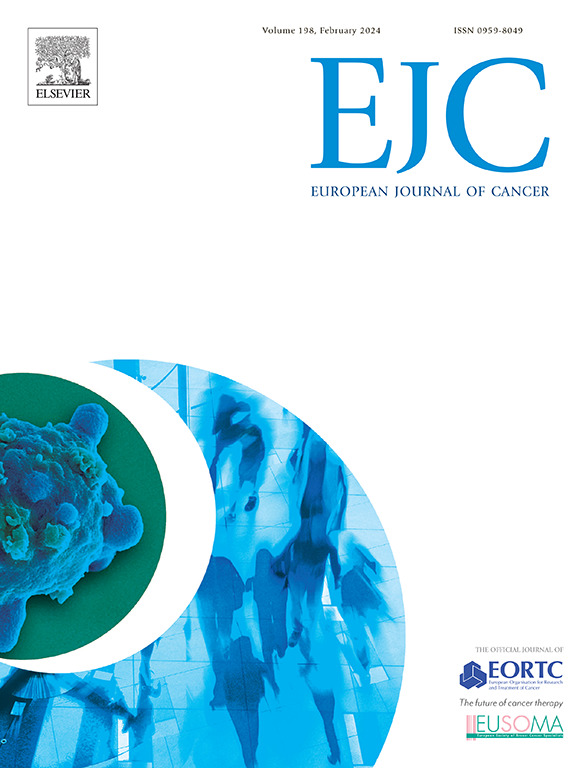A first-in-human phase 1/2 dose-escalation study of MAK683 (EED inhibitor) in patients with advanced malignancies
IF 7.6
1区 医学
Q1 ONCOLOGY
引用次数: 0
Abstract
Purpose
MAK683, a first-in-class and highly selective allosteric inhibitor of the embryonic ectoderm development subunit of polycomb repressive complex 2, has shown sustained antitumor activity in tumor xenograft models. This first-in-human phase 1/2 study evaluated the safety, pharmacokinetics (PK), and clinical activity of single-agent MAK683 in advanced malignancies.
Methods
MAK683 was administered fasted once daily or twice daily continuously in 28-day treatment cycles. Safety assessments included the nature of dose-limiting toxicities (DLTs) and the incidence and severity of adverse events (AEs) and serious AEs. The PK profile of MAK683 was assessed in sequential blood samples of cycles 1–6, and pharmacodynamic profiles were measured by H3K27me3 changes from baseline.
Results
Overall, 139 patients (clear cell carcinoma of the ovary [CCCO], 9 [6.5%]; castration-resistant prostate cancer [CRPC], 22 [15.8 %]; diffuse large B-cell lymphoma [DLBCL], 31 [22.3%]; epithelioid sarcoma [ES], 17 [12.2 %]; gastric cancer [GC], 37 [26.6 %]; nasopharyngeal carcinoma [NPC], 17 [12.2 %]; SWI/SNF-mutated sarcoma, 6 [4.3 %]) received MAK683. Median duration of exposure was 57 days (range: 4–1006). Fifteen patients experienced 22 DLTs including thrombocytopenia (4.9 %) and febrile neutropenia (3.3 %). MAK683-related AEs were reported in 98 patients (70.5 %); 43 patients had grade 3/4 drug-related AEs, including neutropenia, thrombocytopenia, and anemia. MAK683 was quickly absorbed, with peak plasma concentrations ranging from 0.975 to 4.08 h. Median progression-free survival was 1.9 months (90 % confidence interval [CI]: 1.8–2.3), and overall response rate was 5.8 % (90 % CI: 2.52–11.03 %). Clinical activity was observed in patients with advanced DLBCL and ES.
Conclusion
Overall, MAK683 treatment was well tolerated, and clinical activity was observed in patients with advanced DLBCL and ES.
Clinical Trial Information
NCT02900651.
MAK683 (EED抑制剂)在晚期恶性肿瘤患者中的首次人体1/2期剂量递增研究
目的:作为多梳抑制复合物2的胚胎外胚层发育亚基的高选择性变构抑制剂,MAK683在异种肿瘤移植模型中显示出持续的抗肿瘤活性。这项首次人类1/2期研究评估了单药MAK683治疗晚期恶性肿瘤的安全性、药代动力学(PK)和临床活性。方法:口服MAK683,每天1次或每天2次,疗程为28 d。安全性评估包括剂量限制性毒性(dlt)的性质以及不良事件(ae)和严重ae的发生率和严重程度。在周期1-6的连续血液样本中评估MAK683的PK谱,并通过H3K27me3从基线变化测量药效学谱。结果:139例(卵巢透明细胞癌[CCCO], 9例[6.5%];去势抵抗性前列腺癌[CRPC] 22例[15.8%];弥漫性大b细胞淋巴瘤(DLBCL) 31例[22.3%];上皮样肉瘤[ES], 17例[12.2%];胃癌[GC] 37例[26.6%];鼻咽癌17例[12.2%];SWI/ snf突变肉瘤6例(4.3%)接受MAK683治疗。暴露的中位持续时间为57天(范围:4-1006)。15例患者经历了22次dlt,包括血小板减少症(4.9 %)和发热性中性粒细胞减少症(3.3 %)。98例患者报告mak683相关不良事件(70.5 %);43例患者发生3/4级药物相关不良事件,包括中性粒细胞减少症、血小板减少症和贫血。MAK683吸收迅速,血药浓度峰值范围为0.975 ~ 4.08 h。中位无进展生存期为1.9个月(90 %可信区间[CI]: 1.8-2.3),总缓解率为5.8% %(90 % CI: 2.52-11.03 %)。观察晚期DLBCL和ES患者的临床活性。结论:总体而言,MAK683治疗耐受性良好,并且在晚期DLBCL和ES患者中观察到临床活性。临床试验信息:NCT02900651。
本文章由计算机程序翻译,如有差异,请以英文原文为准。
求助全文
约1分钟内获得全文
求助全文
来源期刊

European Journal of Cancer
医学-肿瘤学
CiteScore
11.50
自引率
4.80%
发文量
953
审稿时长
23 days
期刊介绍:
The European Journal of Cancer (EJC) serves as a comprehensive platform integrating preclinical, digital, translational, and clinical research across the spectrum of cancer. From epidemiology, carcinogenesis, and biology to groundbreaking innovations in cancer treatment and patient care, the journal covers a wide array of topics. We publish original research, reviews, previews, editorial comments, and correspondence, fostering dialogue and advancement in the fight against cancer. Join us in our mission to drive progress and improve outcomes in cancer research and patient care.
 求助内容:
求助内容: 应助结果提醒方式:
应助结果提醒方式:


